Apodasmia similis (Oioi, Jointed Wire Rush)
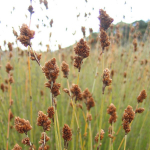
Apodasmia similis, commonly called oioi, is an attractive wetland reed with fine grey-green leaves and brownish bracts at the joints. Popular structural landscaping plant. A great option for mass planting on wet or coastal sites, growing in extremes of wind and salt.
A hardy plant tolerant of most soil types that is often used in riparian plantings. Plant communities that include Carex maorica, Carex secta, Carex virgata, Carex geminata, Phormium tenax and Eleocharis acuta often include Apodasmia similis. Recently, Apodasmia similis has become popular in landscape designs as it has an interesting texture and survives in a range of positions and is an easy NZ natives solution to wet or dry problem areas.
Habitat: Mostly coastal in estuaries, saltmarshes, dunes and sandy flats and hollows. Occasionally inland in gumland scrub, along lake margins, fringing peat bogs or surrounding hot springs.
Flowering: Spring [October - December]
Fruiting: Summer [December - March]
FoodSource for: Birds(I), Insects, Lizards
My Lists: DrainField, Erosion Control, Wetland, Pioneer Species
Arthropodium cirratum (Renga Renga, Rock Lily)
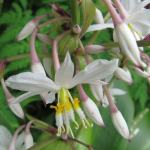
Arthropodium cirratum, commonly called Renga Renga or Rock Lily, is used widely as a ground-cover for dry shade and under trees. Forms large clumps of broad, medium-green, arching foliage. Graceful sprays of white star-shaped flowers from spring to mid-summer. Found naturally throughout NZ in coastal areas. Effective planted in groups. Tolerates coastal winds. Gets frosted back in Canterbury. Hardy.
This herbaceous perennial is grown for its foliage and flowers. It grows as a clump and bears soft and lush, dark green foliage held with a gentle arch. Masses of starry, white flowers are borne on wispy stems through spring and summer and are followed by fruits and seeds that attract birds. This plant is found naturally throughout NZ in coastal areas where it typically grows to as a tidy clump to about 75 cm tall and the same wide. It grows best when planted in full sun or partial shade on a well-drained, frost free site, though will tolerate dry and exposed conditions. The Renga Renga Lily is commonly mass planted as a groundcover, used in cottage or white gardens, included in borders, or planted around outdoor living areas.
Habitat: Found growing in dry, rocky coastal regions.
Flowering: Spring - Summer [September - December]
Fruiting: Summer [January - February]
Astelia chathamica Silver Spear (Silver Spear)
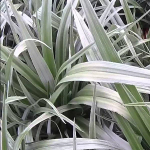
A popular flax-like plant with silvery leaves that droop at the tips and red-orange fruit in autumn. A stunning native New Zealand feature for home gardens and landscaping.
Flowering: Summer [December - January]
Fruiting: Autumn [February - April]
Astelia fragrans (Kakaha, Bush Lily)
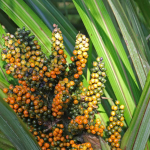 Sold Out
Sold Out
Astelia fragrans, commonly known as bush lily, bush flax or kakaha, is the most common astelia species found in New Zealand. It grows from sea level to elevations of approximately 900 metres. It has attractive broad green flax-like leaves, stiffly arched and the ribs are often reddish. It has scented flowers in Spring. When the berries mature over summer, they turn orange. Lizards feed on the berries and use the foliage to hide, making any Astelia a good addition if you want to attract lizards to your garden. Best in sheltered semi-shade.
Habitat: Kakaha occupies a range of semi-shaded, moist sheltered sites. It can be found on forest floors, cliffs, rock bluffs, lakeshore scarps and stream margins, as well as in swamps.
Flowering: Spring [October - January]
Fruiting: Summer - Autumn [January - May]
FoodSource for: Birds(F,N), Insects, Lizards
Astelia grandis (Kakaha, Swamp Astelia)
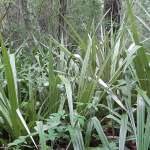 Sold Out
Sold Out
Astelia grandis, or Kakaha, is the largest of our Astelias, growing to 2m much like Harakeke. It has very broad olive green leaves with a silvery sheen beneath and reddish-purple midribs. The leaves are more erect and less tapered than A.fragrans. Forms clumps to 2m. The Female has orange berries. As a result, the female plant is a good lizard and bird attractor. These sweet juicy berries are edible even when raw.
It is an understory plant in lowland swamp forests or Kahikatea forests, but it is found mostly in the warmer areas of the South Island. Dioecious, meaning male and female plants must be grown if seed is required
Habitata: Kakaha occupies a range of moist sites. It can be found on forest floors, cliffs, rock bluffs, lakeshore scarps and stream margins, as well as in swamps. Best in sheltered semi-shade.
Flowering: Spring [September - October]
Fruiting: Summer [December - February]
Astelia nervosa (Kakaha, Mountain Astelia)
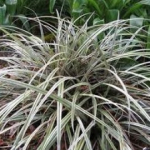 Sold Out
Sold Out
Astelia nervosa, commonly known as Mountain Astelia, is a distinctive evergreen perennial plant that is native to New Zealand. It belongs to the Asteliaceae family and is known for its striking foliage and unique form, making it a popular choice for ornamental gardens and landscapes.
The leaves of Astelia nervosa are the main feature of this plant. They are long, narrow, and sword-shaped, with a silvery-blue or grey-green color. The leaves are arranged in a clumping, basal rosette form, and can grow up to 90 centimeters in length, creating a dramatic and architectural presence in the garden.
The foliage of Astelia nervosa is typically stiff and leathery, with serrated edges, and may have a slight twist or curl, adding to its unique appearance. The silver-blue or grey-green color of the leaves provides a striking contrast against other plants in the garden and can create a bold focal point or add texture and interest to mixed plantings.
Astelia nervosa produces inconspicuous flowers that are held on tall, slender stalks that rise above the foliage. The flowers are typically small, brownish or greenish in color, and are followed by small, fleshy fruit.
Astelia nervosa is a hardy plant that is well-adapted to a range of growing conditions, although it prefers well-drained soils and partial shade to full sun. It is tolerant of coastal conditions, making it suitable for coastal gardens, and is also known to be deer-resistant.
In landscaping, Astelia nervosa is often used for its striking foliage and unique form. It can be used as a specimen plant, in mixed plantings, or in containers to create a bold and dramatic focal point. It is also well-suited for modern or contemporary gardens, as well as tropical or exotic-themed gardens.
Habitat: Found on mountainsides in forests and damp grasslands in the montane to the sub-alpine zone.
Flowering: Summer [January - February]
Fruiting: Autumn [February - May]
My Lists: Pioneer Species
Astelia nervosa Westland (Bronze Bush Flax)
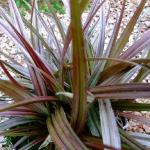 Sold Out
Sold Out
Astelia nervosa Westland with its fabulous foliage is ideal for group planting. Silvery, strap like foliage that is attractively flushed with red and bronze tones. The red colour intensifies in cold weather. Tolerant of sun or part shade but not tolerant of 'wet feet'. Astelia look their best when group planted and they are a fabulous easy care architectural container plant. Evergreen. Hardy.
Flowering: Summer [January - February]
Fruiting: Autumn [February - May]
Austroderia richardii (Toetoe)
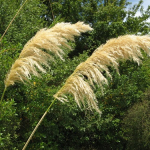
Austroderia richardii, commonly known as toetoe, is a large perennial tussock grass species that is native to New Zealand. It belongs to the family Poaceae and is endemic to the country, meaning it is found nowhere else in the world.
Austroderia richardii has distinctive features that make it easily recognizable as its one of the tallest grass species in New Zealand. The leaves are long and narrow, with a rough texture, and can grow up to 1.5 meters in length. The leaf margins are often serrated or toothed, giving them a slightly serrated appearance.
Austroderia richardii is typically found in wetland habitats, such as swamps, bogs, and riverbanks, although it can also occur in other types of habitats, including coastal dunes and forest clearings. It is an important plant for wetland ecosystems, providing habitat and food for a variety of birds, insects, and other wildlife.
Toetoe has been used by Māori, the indigenous people of New Zealand, for various purposes. The leaves have been used for weaving, thatching, and as bedding material, while the flower heads have been used for decorative purposes. Today, Austroderia richardii is also cultivated as an ornamental grass in gardens and landscaping due to its impressive size and striking appearance.
Overall, Austroderia richardii, or toetoe, is a prominent grass species in New Zealand, known for its tall stature, feathery flower heads, and importance in wetland ecosystems and cultural uses. A very tough, hardy and fast growing withstanding strong winds, costal conditions, drought and cold conditions.
On farm, Austroderia richardii is a good wind break once established as they grow in clumps and are very hardy plants that can withstand many weather conditions. Protects stock and stays below pivot irrigation, also useful in runoff prevention and along water courses. Toe toe is an attractive bank stabilisation plant, good for a range of soils and suits riparian plantings.
Habitat: Abundant, from the coast to subalpine areas. Common along stream banks, river beds, around lake margins, and in other wet places. Also found in sand dunes.
Flowering: Spring [September - November]
Fruiting: Summer [October - March]
My Lists: DrainField, Erosion Control, Wetland, Pioneer Species
Carex secta (Pukio, Swamp Sedge)
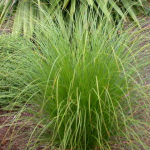
Carex secta, commonly called Swamp Sedge or Pukio, is a well known species and it is a most useful plant for use in re-establishing or enhancing wetland areas. Common to swampy areas and in standing water and it is a most useful plant for use in enhancing wetlands and ponds. Older plants in moist to wet sites, often form thick trunk-like bases 1 metre tall from its own tightly matted roots. It takes on a yellow-green colour in open situations with the colour being intensified in the Winter. Attractive dark brown seed heads in summer. Great for bank stabilisation and riparian planting.
Endemic to New Zealand, found throughout the country. Carex secta is riparian species. It is often found in plant communities that include but are not limited to Apodasmia similis, Carex maorica, Carex virgata, Phormium tenax, and Eleocharis acuta.
Habitat: Widespread in suitable wetlands from coastal to montane wetlands.
Flowering: Summer [October - January]
Fruiting: Autumn [October - March]
My Lists: DrainField, Erosion Control, Wetland, Pioneer Species
Carex testacea (Speckled Sedge, Orange Sedge)
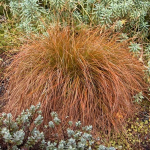
Carex testacea, commonly known as Orange or Speckled Sedge, is a clump-forming perennial grass-like plant that belongs to the family Cyperaceae. It is native to New Zealand and is widely cultivated as an ornamental plant in many parts of the world.
Carex testacea is known for its distinctive foliage, which undergoes color changes throughout the year. The leaves are typically narrow and linear, and they emerge in shades of green, gradually turning to a warm bronze, copper, or orange color as they mature. The foliage has a fine, hair-like texture, which gives the plant a unique and ornamental appearance.
The plant typically grows in dense tufts or clumps, with stems that are typically upright or slightly arching, reaching a height of 30 to 60 cm. The stems are usually smooth and glossy, and they may develop a reddish coloration towards the base.
Carex testacea is a relatively low-maintenance plant that is tolerant of a wide range of growing conditions. It prefers well-draining soils and can tolerate partial to full sun, although it may exhibit more intense coloration in brighter light. It is drought-tolerant once established, making it suitable for water-wise gardens. Evergreen. Hardy.
Habitat: Coastal to montane. In sand dunes, coastal forest and scrub, dense forest or short tussock (Festuca novae-zelandiae) grassland.
Flowering: Spring [September - December]
Fruiting: Summer [December - May]
My Lists: Pioneer Species
Carex virgata (Pukio, Swamp Sedge)
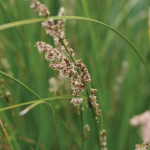
Carex virgata, commonly called Swamp Sedge or Pukio, is a vigorous sedge suitable for swamps, drain margins, seepages and wet pastures. A successful colonising plant, used for wetland planting and revegetation. Suitable for conditions which may vary periodically from very wet to very dry. More dry tolerant and shorter than C. secta. Evergreen. Hardy.
It pairs well with Carex secta (also called Pukio) for bank stabilisation. As it handles being in a swampy area, it is ideal for lower bank planting in riparian revegetation projects. It is also useful in water treatment projects as it minimises nutrient runoff. This makes it ideal for planting streamside on farms.
Carex virgata is widespread in open, swampy conditions and also in damp sites within lowland forest. In parts of the country this sedge is often the dominant carice of lowland alluvial forest. Found in communities that include but are not limited to Apodasmia similis, Carex maorica, Carex secta, Phormium tenax, and Eleocharis acuta.
Habitat: Widespread from sea level to about 1000 m a.s.l. in open, swampy conditions and also in damp sites within lowland forest. In parts of the country this sedge is often the dominant carice of lowland alluvial forest.
Flowering: Spring [October - December]
Fruiting: Summer [December - May]
My Lists: DrainField, Wetland
Coprosma acerosa (Tataraheke, Sand Coprosma)
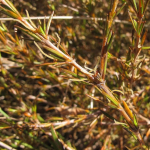
Coprosma acerosa, or sand coprosma, is a groundcover that is found naturally near the coast throughout New Zealand. Great for windy, coastal areas which get dry winds. The small needle-like deep green leaves clothe the intertangling branches that form springy mounds with a spread of up to 1m. Useful grown in areas prone to erosion, on banks, or over walls. Can also be easily incorporated into mixed shrub planting as a ground cover. In addition to bank stabilisation and as a mixed groundcover, native gecko species love the berries. As a result, this is a good addition to a revegetation project looking to increase biodiversity in the area. When plants of both sexes are present, attractive smoky blue berries follow the tiny green flowers. This is an excellent plant for coastal areas and hot dry conditions.
Habitat: Coastal sand dunes.
Flowering: Spring [September - December]
Fruiting: Autumn [February - May]
My Lists: Erosion Control
Coprosma brunnea (Brown Stemmed Coprosma)
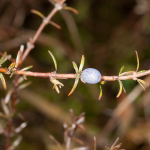
Coprosma brunnea is one of 45 species of Genus Coprosma that are found in New Zealand. A hardy wiry shrubby groundcover that is very tough and suitable for harsh conditions. Dense and bushy with attractive chocolate brown coloured foliage, grows tight and covers well. Ideal for trimming and mass planting on banks and swales, or sprawling down steep hill faces. Very small flowers develop from August to October among the branches and the female plant, in January, develop 5-6 mm long drupes which are a translucent sky-blue or are translucent white with blue flecks.
They also provide habitat for New Zealand’s declining lizard and gecko populations. As attractors of these small animals, they are a pioneer shrub in revegetation projects. Mingimingi provides a tough shelter, providing good food for native birds and lizards, as well as ground cover for these. Hardier the C. acerosa.
Coprosma species have small unisexual flowers that are borne on different plants (dioecious) and they have a fleshy fruit (drupe).
Habitat: Plains to subalpine. Coprosma brunnea grows in lowland to higher montane river beds up to 1500m in open grassland and rocky places on the South and Stewart Islands of New Zealand.
Flowering: Spring [August - December]
Fruiting: Summer - Autumn [January - June]
My Lists: DrainField, Erosion Control, Pioneer Species
Coprosma rhamnoides (Red-fruited Coprosma)
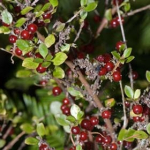
Coprosma rhamnoides is a dense tightly divaricating shrub. Tiny light green leaves. Stiff red/brown branches. Good for exposed, dry areas. N.Z. flora has a large number of shrubs with small tough leaves and wiry interlacing branches – divaricates. Some even have brown or grey new growth, giving a dead-like unattractive appearance. It is suggested that this may be a defensive growth mechanism to deter visits from browsing moa. Coprosma rhamnoides is a good example.
In October the plants develop small pale cream flowers which are dioecious (sexes separate). These flowers are wind pollinated. Drupes appear on the female plant in March-April small (3-4mm) red berries, turning dark red or black as they ripen.
Habitat: It is widespread in Canterbury and Westland in lowland to lower montane-scrubland and forest mostly as an understorey plant. It is less common higher in the montane zone.
Flowering: Spring [October - November]
Fruiting: Autumn [March - April]
Cordyline australis (Ti Kouka, Cabbage Tree)
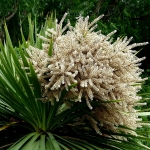
Cordyline australis, Ti Kouka, commonly called Cabbage Tree, is one of the most identifiable New Zealand native plants in the landscape. It has a tall straight trunk or trunks and a dense round head, with a sphere of long narrow leaves. Cabbage tree produces a profusion of attractive and scented flowers in spring. It is an abundant seeder. It looks most natural in the ornamental garden if planted in groups. Three or more plants can be planted together in the same hole to produce this effect. It grows in all soils and situations, even in swampy ground, where little else of interest will grow.
Cordyline australis is a light-demanding pioneer species, and seedlings die when overtopped by other trees. To grow well, young plants require open space so they are not shaded out by other vegetation. Its fruit and nectar are a favourite food source for kererū and tūī. Bellbirds like to nest in Tī Kōuka. Some lizards forage among the flowers of Cordyline australis and the nectar of the flowers is sought after by insects.
History of use: The Maoris obtained a most nutritious food, kauru, from the root of the young cabbage tree. This root is an extension of the trunk below the surface of the ground and is shaped like an enormous carrot some 2–3 ft long. An observer of the early 1840s, Edward Shortland, noted that the Maoris “prefer those grown in deep rich soil; they have learned to dig it at the season when it contains the greatest quantity of saccharine matter; that is, just before the flowering of the plant. They then bake, or rather steam it in their ovens. On cooling, the sugar is partially crystallised, and is found mixed with other matter between the fibres of the root, which are easily separated by tearing them asunder, and are then dipped in water and chewed”. The trunk of the cabbage tree is so fire-resistant that early European settlers used it to make chimneys for their huts. They also brewed beer from the root.
Medical Uses: An infusion of the leaves was used for dysentery and diarrhoea and for cuts. (From "Maori medical lore" by W. H. Goldie. 1905) The leaves were softened by rubbing and scraping. These scrapings were applied as an ointment to cuts, cracks in the skin and sores (from unpublished notes by Beryl Moore 1940). The younger inner shoots and the top of the stem were boiled and eaten by nursing mothers and were given to their children for colic. (From unpublished notes by T. Kururangi 1941)
Habitat: Widespread and common from coastal to montane forest. Most commonly encountered on alluvial terraces within riparian forest.
Flowering: Spring [October - December]
Fruiting: Summer - Autumn [January - April]
My Lists: Erosion Control, Wetland, Pioneer Species
Corokia buddleioides
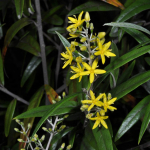
Corokia buddleioides has pale green/bronze glossy leaves. Yellow flowers (spring). Red berries (autumn). Ideal hedging. Distributed in the North Island. Northland south to outliers in New Plymouth and the volcanic plateau, not seen east of Bay of Plenty.
Habitat: Coastal to lowland forest and forest margins.
Flowering: Spring [September - December]
Fruiting: Summer - Autumn [January - May]
Corokia cotoneaster (Korokio)
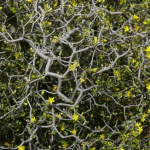
Corokia cotoneaster, or Korokio, is a good hedging and ornamental shrub. Corokia cotoneaster prefers to survive in areas that are not wet. It will grow and develop in dry, rocky, and dense soils. Attractive fine silver/grey foliage with bright yellow flowers in early summer. Densely interlaced branchlets. Red berries/seed. Evergreen. Very hardy to drought and cold.
As it is a tough plant that attracts birds and lizards, it is suitable for restoration projects. As part of the dry woodland community, it plays an important role in conditioning the soil. The soil conditioning creates a more hospitable environment for less robust species and broadleaf/podocarp forest succession. Other plants in this community include but are not limited to Discaria toumatou, Poa cita, Ozothamnus leptophyllus, Sophora prostrata, Melicytus alpinus and Cordyline australis.
Habitat: Found in scrub and on dry river flats and rocky places throughout the country.
Flowering: Spring [September - December]
Fruiting: Summer - Autumn [January - May]
Dianella nigra (Turutu, NZ Blueberry)
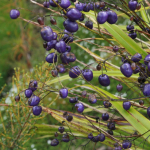
Dianella nigra, Turutu, has bright iridescent blue berries in summer, this small evergreen flax like plant works well in most situations and is especially attractive planted naturally in groups. Ideal for dry areas under existing vegetation. Turutu grows up to 50 cm tall and about 50 cm wide, making it a perfect smaller substitute for flaxes and does much better in semi shade than the unrelated mountain flax. The magnificent bright blue and fleshy berries that arise during summer from tiny white flowers with yellow stamens. The berries are spread and eaten by native birds.
Habitat: Coastal to montane (rarely subalpine) . Colonising a wide variety of habitats from open coastal headlands, gumland scrub and less frequently peat bogs through to dense forest and subalpine scrub.
Flowering: Spring [November - December]
Fruiting: Summer - Autumn [November - May]
Discaria toumatou (Matagouri)
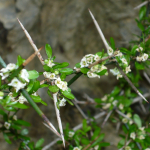
Discaria toumatou, commonly called Matagouri, is a tangle-branched, extremely thorny, divaricating shrub or small tree up to five metres tall. It has small leathery leaves close to the thorns, which are only abundant in spring or the shade. The flowers are tiny and white with no petals. It is the only New Zealand native plant that has thorns. Nitrogen-fixer. Common in dry shrublands of the eastern South Island.
It is most common in tussock grassland, stony areas and river beds. It is common in the eastern South Island, and found in a few coastal localities in the North Island south from the mouth of the Waikato River. As with other Discaria species it fixes nitrogen from the atmosphere with the help of symbiotic bacteria of the genus Frankia in its roots. It often grows in association with mingimingi (Coprosma propinqua), porcupine shrub (Melicytus alpinus, an alpine mahoe) and native brooms (Carmichaelia species). Seeds are dispersed by ballistic projection and water.
Matagouri plays an important ecological role in providing habitat and food sources for various native bird species, including silvereyes and bellbirds. The dense, spiny branches offer protection from predators and nesting sites for birds. Matagouri also helps stabilise the soil and prevent erosion in exposed and fragile environments.
As a native plant matagouri has complete protection on public conservation land and a degree of protection on private land under the Resource Management Act 1991. In a notable case a 400 ha area of matagouri forest, including trees that may have been 150 years old, was illegally sprayed at the head of Lake Sumner in 2001.
Habitat: Found in dry riverbeds, open rocky places and sand dunes from coastal to subalpine.
Flowering: Spring - Summer [October - January]
Fruiting: Summer [December - March]
Dodonaea viscosa (Ake Ake)
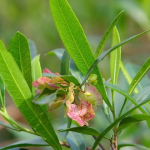
Dodonaea viscosa, commonly called Akeake, is an ornamental small bushy erect tree. Attractive brown flaky bark. The long shining leaves are bright green and dense on erect branches. The seed capsule is most attractive in the autumn. Wind resistant, and grows in coastal sites. Good for shelter in light sandy soils.
Habitat: Coastal to lowland forest, occupying a range of habitats from dunefields and boulder beaches through coastal scrub to lowland forest. Rarely forming a dominant tree in coastal forest.
Flowering: Spring - Summer [September - January]
Fruiting: Summer - Autumn [November - April]
Festuca novae zelandiae (Hard Tussock)
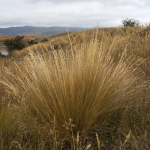
Festuca novae-zelandiae is a fine-leaved tawny tussock, upright in habit. A common component of low tussock grasslands on dry, windy and cold plains in Canterbury & Otago. It is deep rooted and dominant on steep, exposed slopes. In alpine areas at lower altitudes Festuca novae-zelandiae is associated with the narrow-leaved snow tussock (Chionochloa rigida). Stunning grass en masse. Needle thin erect leaves green to blonde. Tolerates poor soil and dry conditions.
The tawny leaves are 15-60cm long and have a width of 0.5-1mm. They are rough to touch and have sharply pointed tips. The margins are tightly in rolled giving the leaf a cylindrical appearance. The flowering stems are up to 70 cm tall with a 5-12 cm long open flowering panicle.
Habitat: Short tussock grasslands. Pre-1900s short tussock grassland covered considerable areas of the eastern South Island from sea level up to between 800 and 900 metres high.
Flowering: Spring [September - November]
Fruiting: Summer [December - February]
Fuchsia excorticata (Kotukutuku, Tree Fuchsia)
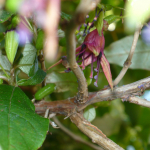 Sold Out
Sold Out
Fuchsia excorticata, also known as Kotukutuku, Tree Fuchsia, and New Zealand Fuchsia. Native to New Zealand and considered to be the worlds largest fuchsia. Attractive, small flowers begin to appear in mid spring. They are greenish-yellow then turn purple-red. followed by dark purple berries that are edible and tasting similar to tamarillo. It is easily recognised in its native environment by the characteristic appearance of its bark, which peels spontaneously, hanging in red papery strips to show a pale bark underneath. Plant in full sun or partial shade, hardy, semi-deciduous to deciduous.
Kōtukutuku is also a favoured food for bees. Other native trees that provide excellent food for honey bees and our own native bees (Leioproctus, Lasioglossum, and Hylaeus genera), are Psuedopanax arboreus, Cordyline australis, Schefflera digitata, Kunzea, and Pittosporum tenuifolium.
Habitat: Found in lowland and montane forests, especially along forest margins and streamsides where the soil is damp.
Flowering: Winter - Spring - Summer [July - January]
Fruiting: Summer [November - March]
My Lists: Winter Pollen
FoodSource for: Birds(F,S,N,O), Bees, Insects, Lizards
Fuchsia procumbens (Creeping Fuchsia)
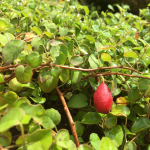
Fuchsia procumbens, or Creeping Fuchsia, is a rather exotic Fuchsia, unlike most common types, unique for its creeping habit. This species grows much like a groundcover, often not exceeding more than a few inches in height. Bears pretty rainbow flowers followed by firm-fleshed, edible berries.
It is now a rare species in the wild because of the destruction of its natural habitat and is listed as an endangered plant species.
Habitat: Fuchsia procumbens is a prostrate shrub that is endemic to coastal areas of the North Island of New Zealand. A strictly coastal species. F. procumbens has been collected from cobble/gravel beaches, coastal cliff faces, coastal scrub and grassland, dune slacks and swales, and from the margins of saltmarshes (in places where it would be inundated during spring tides).
Flowering: Spring - Summer [September - May]
Fruiting: Summer - Autumn [November - July]
My Lists: Rare Plants
Kunzea ericoides (Kanuka)
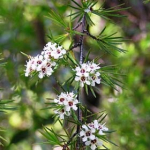
Kunzea ericoides, Kanuka tree, is a fast growing tree found throughout the north of the South Island. The leaves are softer to touch than Manuka and has smaller white flowers in Summer. It is very hardy, tolerating drought, frosts and poor soils. It is a primary colonising plant and used for revegetation as a nurse plant. Both manuka and kanuka are used as a nurse crop with other early colonizing plants for revegetation / restoration planting and are also very effective in erosion control. It is fast-growing, but short-lived, living up to 150 years. A juvenile takes about seven years to reach reproductive maturity. Very hardy.
History of use: The name "tea-tree" comes from the early bushman who used Manuka and Kanuka leaves to brew a drink similar to tea. Captain Cook was the first person to brew tea from manuka and said that it had a very agreeable, bitter taste when made with fresh leaves, but lost some of it piquancy when made with dry leaves. Kanuka leaves produce a tea that isn't quite as flavourful. Both tea-trees supposedly have medicinal uses and properties whose benefits far outweigh any considerations of taste. The leaves, brewed in water, help urinary complaints and reduced fevers.
The Maori and early settlers used to chew young shoots or swallow a drink made from seed capsules as a cure for dysentery and diarrhoea. The liquid from boiling the bark was used to treat constipation, as a sedative to promote sleep and reduce fever, for bathing sore eyes, treating colic, inflamed breasts, scalds and burns. The white gum was applied to scalds and burns and was taken by adults and children to relieve coughing. There are much more medicinal uses to which tea-tree was put to. Kanuka flowers produce a reasonable amount of nectar that is quite favoured by honeybees. The thick golden honey is hard to remove from honeycombs, but is quite popular for its strong taste and reputed antibacterial properties. Nowadays New Zealand’s monofloral Manuka and Kanuka pharmaceutical honey are both renowned for their natural health benefits.
The tough wood was used by Maori for implements such as fern root beater, mauls, paddles, weapons, spade blades, weeders, digging sticks and bird spears. The timber was noted for its straight grain, durability and strength by early European settlers, and was in demand for wheel-spokes, tool handles and other such purposes. Kanuka and Manuka wood is commonly used as firewood, especially for barbeques, or charred into charcoal. Older trees of have their trunks covered with a light brown bark that readily strips off, and is frequently used for fire-kindling. Both Manuka and Kanuka branches have been used to make brush brooms.
Habitat: Coastal to lowland shrubland, regenerating forest and forest margins, also present in montane forest, ultramafic shrubland and very occasionally present in subalpine shrubland.
Flowering: Spring - Summer [September - February]
Fruiting: Autumn [March - April]
My Lists: Erosion Control, Pioneer Species
(Taxonomists recently confirmed that K ericoides, K robusta, and K serotina are all the same species and declared all South Island Kānuka Kunzea ericoides.)
Leptospermum scoparium (Manuka, Tea Tree)
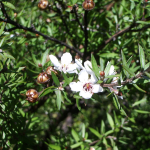
Leptospermum scoparium, the Manuka tree (or Tea Tree), is a fast growing shrub with abundant white flowers in Summer. The flowers are attractive to bees. Both manuka and kanuka are used as a nurse crop with other early colonizing plants for revegetation / restoration planting and are also very effective in erosion control.
Mānuka is often confused with the related species kānuka (Kunzea ericoides) – the easiest way to tell the difference between the two species in the field is to feel their foliage – mānuka leaves are prickly, while kānuka leaves are soft. Alternatively, the seed capsules of mānuka are large (5–7 mm in diameter) and often remain on the plant year round, whereas the seed capsules of kānuka are much smaller (2.2–4.6 mm in diameter) and are not present for much of the year.
History of use: The wood was often used for tool handles. Mānuka sawdust imparts a delicious flavour when used for smoking meats and fish. It is cultivated in Australia and New Zealand for mānuka honey, produced when honeybees gather the nectar from its flowers, and for the pharmaceutical industry. An essential oil, for which many medicinal claims are made, is produced by steam distillation of its leaves.
Habitat: Abundant from coastal situations to low alpine habitats.
Flowering: Spring - Summer [September - March]
Fruiting: Autumn - Summer [Throughout the year]
My Lists: Erosion Control, Wetland, Pioneer Species
Libertia peregrinans (Mikoikoi, NZ Iris)
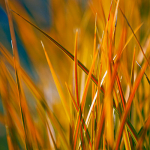 Sold Out
Sold Out
Libertia peregrinans, commonly known as Mikoikoi, is a NZ Iris that has stiff golden coloured leaves. The flowers are pure white and are held on stems amongst the leaves. Spreads by means of underground runners, forming large clumps.
Habitat: A primarily coastal or lowland species of sandy, peaty or pumiceous soils. It may be found growing in dune slacks and swales, on the margins of swamps, in open poorly draining ground under scrub.
Flowering: Spring [October - January]
Fruiting: Summer [January - February]
Melicytus alpinus (Porcupine Shrub)
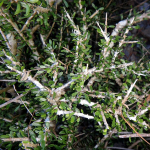
Melicytus alpinus get their common name, porcupine shrub, from the long, almost leafless, spindly branches which resemble the quills of a porcupine. Its leaves are narrow and generally have smooth margins with a few exceptions with serrated edges, however, they do only have a small amount of leaves and they are only approximately 1cm long. Hard and dense, slow-growing in coastal or alpine areas of southern North Island and the South Island it looks almost leafless. But most of the leaves are sheltered between the stiff interlacing stems as an adaptation to the harsh environment where the plant grows. Leaves are variable, leathery.
Melicytus alpinus is very well adapted to extreme weather conditions such as drought, which is why it can be found in areas such as the heavily modified high country of the South Island.
Melicytus alpinus is a habitat to many lizards endemic to New Zealand, this group of lizards include both skinks and geckos. This relationship is mutually beneficial as the lizards use the porcupine shrub as protection from weather and/or predators and in turn eat and spread the seeds from the shrub's berries.
Habitat: Occurs east of the Southern Alps in exposed rocky places between 600m and 1.300m. Found in the wild on very light sand or rocky soils, or on rock outcrops in full sun though it grows on any well-drained soil.
Flowering: Summer [November - January]
Fruiting: Autumn [February - April]
My Lists: Rare Plants
Melicytus crassifolius (Thick-leaved Mahoe)
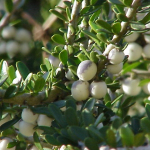
Melicytus crassifolius is heavily-branched, with arching stems that taper at the tips to a sharp point. The small bright olive green leaves are teardrop shaped. It has small, greenish, bell-shaped flowers which appear underneath branches in summer, They form in clusters along the branches. The fruit is small bright white berries and they develop late summer until early winter. Usually, a blue spot appears on the berry with age.
Habitat: This compact hard shrub is endemic to both the North and South Island where it is typically found along coastal lowlands (0-300 m a.s.l.). Usually coastal in open grey scrub, on talus and alluvial terraces, cobble beaches, cliff faces, and in coarse stable sand dunes (especially swales). Inland it may be found in open grassland, amongst kanuka stands and along river flats.
Flowering: Summer [August - January]
Fruiting: Autumn [October - May]
Melicytus ramiflorus (Mahoe, Whiteywood)
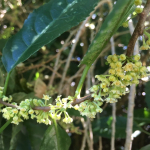 Sold Out
Sold Out
Melicytus ramiflorus, commonly known as Whiteywood or Mahoe, is one of our most common trees, found in forest and shrub throughout New Zealand and growing quickly to 5m or more. The pointed oval leaves are a bright green, with fresh growth being quite soft and an even brighter green. The bark is greyish white and becomes attractively mottled with lichens. Flowers in spring followed by numerous purple black berries. Whiteywood can be clipped for hedging or used as a shelter tree or filler, and will also make quite an attractive specimen. Avoid heavy frosts when young.
The berries of Māhoe are eaten by a number of native birds, including kererū and tui, and some geckos. It is frequently seen in areas of regenerating forest, particularly in areas of disturbed soil. Its early appearance in regenerating forests indicates that it is ideal for revegetation plantings.
Habitat: Abundant small tree of coastal, lowland, and lower montane forests throughout the country.
Flowering: Spring [November - February]
Fruiting: Summer [February - May]
Muehlenbeckia astonii (Pohuehue)
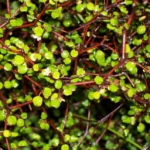
Muehlenbeckia astonii, Pohuehue, is a coastal divaricating shrub with a wiry interlacing habit. Small, bright-green heart-shaped leaves. This plant is extremely hardy, tolerating dry conditions and wind. Popular landscaping plant, providing great contrast. Makes an attractive topiary or hedge. Attracts birds, insects and lizards. Semi-deciduous. Hardy.
Unlike most New Zealand plants M. astonii is leafless in winter. This is when the distinctive branches add interest to the garden. It grows from a distinct trunk and has many fine reddish-brown to orange flexible branches that zigzag around one another to form a dense, interwoven ball. Its flowers, appearing from December to January, are tiny and are greenish to white or pinkish white. The fruits are sweet and edible, eaten by birds and lizards. The plant is an important host for several endemic insect species and in some cases their sole host.
Habitat: Coastal to lowland. This species is associated with “grey” scrub communities, largely confined to drier lowland parts of eastern New Zealand. It is found on moderate to high fertility soils. Its deep root system helps it survive in dry conditions, and can grow on open rocky hillsides and stony ground. It prefers free-draining, warm, sunny slopes, such as the mid-dune areas along the coast. The plant is often found in association with Coprosma crassifolia, Coprosma propinqua, Muehlenbeckia complexa, Discaria toumatou, Olearia solandri and Ozothamnus leptophyllus.
Flowering: Spring - Summer [August - January]
Fruiting: Summer - Autumn [October - April]
Muehlenbeckia axillaris (Creeping Pohuehue)
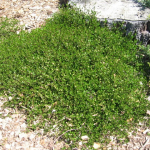 Sold Out
Sold Out
Muehlenbeckia axillaris, commonly known as Creeping Pohuehue or wire vine, is a low dense ground cover, forming wiry mats up to about 1 m in diameter. It spreads along the ground and even underground. It flowers prolifically in summer with masses of small creamy flowers. The flowers are yellowish white, 4-8 mm in diameter, and borne in groups of up to 3 in the axils. Male and female flowers often occur on the same plant and the female flowers form small opaque white fruit. Provides habitat for native copper butterflies. Birds and geckos love the fruit.
This groundcover has stems and small dark green leaves. Muehlenbeckia axillaris has thin wiry red-brown stems, with small dark green leaves that are less than 1 cm in diameter, and 2–4 mm thick. Prefers full sun. Tolerant of hot, dry conditions. Evergreen. Hardy.
Muehlenbeckia axillaris is primarily grown as an ornamental plant for its unique growth habit and attractive foliage. It is often used in rock gardens, coastal gardens, or other landscapes where its trailing habit can be appreciated. It is also used in erosion control and habitat restoration projects due to its ability to stabilize soil and provide cover for wildlife.
Habitat: Found in subalpine rocky places, riverbeds and and grasslands.
Flowering: Summer [November - April]
Fruiting: Autumn [December - April]
My Lists: Erosion Control
Muehlenbeckia complexa (Scrambling Pohuehue)
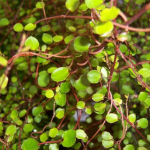 Sold Out
Sold Out
Muehlenbeckia complexa, commonly called scrambling or small-leaved Pohuehue, is quite vigorous and probably the best species for trimming and topiary. It is semi-deciduous, losing most, or all of its leaves over winter. Grows to 4m or more up suitable supports, and produces swollen white berries with black seeds. Leaves turn bronzy before dropping in late fall/early winter. Any reasonably well drained soil will suit this agreeable groundcover, and it'll tolerate drought, salt spray, and wind. Often found growing in the company of Plagianthus divaricatus.
M. complexa can form dense springy mounds, useful for suppressing weeds. In its native environment, it plays a key role in sealing human and natural disturbances on the forest edge. It also suppresses the growth of introduced weeds, such as blackberry, and promotes increased insect diversity. A wide variety of insect species are associated with M. complexa. It is an important host plant for several endemic species of copper butterflies including the coastal copper (Lycaena salustius). It is also a food source for lizards and birds such as tui, bellbird and kererū, which also feed on the buds and leaves.
Habitat: Found along rocky coasts as well as inland in coastal and montane forests.
Flowering: Spring - Autumn [October - February]
Fruiting: Winter [March - June]
My Lists: Erosion Control
Myrsine australis (Mapou, Red Matipo)
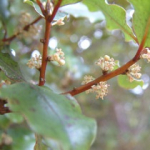 Sold Out
Sold Out
Myrsine australis, or Red Matipo, forms a handsome large shrub or tree with distinctive red branchlets and wavy leaf margins. Similar in appearance to Pittosporum tenuifolium. The cream flowers and later the black fruit are in clusters below the leaves. Used as a specimen, shrub border or hedge.
Habitat: Occurs in lowland forests. Common tree of regenerating and mature forest in coastal to montane situations.
Flowering: Spring - Summer [September - February]
Fruiting: Autumn [February - May]
Myrsine divaricata (Mapou, Weeping Matipo)
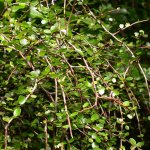
Myrsine divaricata is a small evergreen, bushy shrub, with spreading, drooping branches, which can grow to 6m high. The drooping branches give rise to woody interlacing (divaricating) branchlets bearing solitary leaves or leaves in groups. Tiny flowers, with pale yellow or red petals, occur in clusters. Evergreen.
Habitat: Found in subalpine scrub and forests, preferably where the ground is moist.
Flowering: Winter [June - November]
Fruiting: Spring - Autumn [August - April]
Olearia paniculata (Akiraho, Golden Akeake)
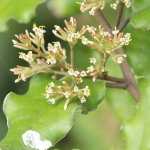
Olearia paniculata, Akiraho, is a rounded small tree with yellowish-green wavy leaves. Flowers small, white, in dense clusters. Fragrant sweet-scented flowers are borne in autumn. A good shelter plant. Hardy and tolerant of coastal conditions.
Due to its attractive appearance and hardiness, Olearia paniculata is sometimes cultivated as an ornamental shrub in gardens and landscapes. It can be utilized as a hedge, specimen plant, or included in mixed border plantings.
Habitat: Found in scrub east of East Cape to south Canterbury
Flowering: Autumn [March - May]
Fruiting: Winter [April - July]
Ozothamnus leptophyllus (Tauhinu, Cottonwood)
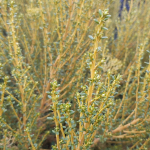
Ozothamnus leptophyllus, commonly called Tauhinu or Cottonwood, is a bushy shrub with small yellow green leaves. It has an attractive golden appearance and flowers in profusion with clusters of tiny cream daisy (wheel-shaped) flowers followed by down-covered seed heads. It is fast-growing, reaching its maximum height of 2 metres in 10–15 years.
Tauhinu can readily colonise bare hillsides and pasture, with seeds readily dispersed by the wind. It grows rapidly, acting as a nursery plant for other species. Unless their under storey plants are heavily grazed, Tauhinu shrublands are usually overtopped by taller shrubs and trees. Because of this, Tauhinu makes an excellent coastal or dry woodland revegetation plant. It prefers a sunny location and is frost hardy.
Habitat: Found in coastal to subalpine shrubland.
Flowering: Summer [December - March]
Fruiting: Autumn [March - April]
My Lists: Pioneer Species
Phormium cookianum (Wharariki, Mountain Flax)
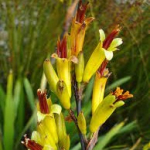
Phormium cookianum, Wharariki, is commonly called Mountain Flax, is a superb species, one of the hardiest and the most striking. Long arching green leaves all year round, and 2 metre long flower stalks over summer - particularly attractive to native birds. Use as a 'groundbreaker' in new gardens, en masse on banks. Foliage and flowers are great for floral artwork.
Phormium cookianum is a flax up to 1-3 metres tall but generally smaller than Phormium tenax. The numerous leaves are 5-12cm wide, thick, fibrous, droopy, and rise from fan-like bases. The tubular 25-40 mm long flowers are a dull pink or yellow colour. The seed capsule is pendulous and twisted.
Habitat: Strictly confined to subalpine, alpine situations, where it mainly grows on cliffs and mountain slopes, in seepages, along stream sides or on the margins of bogs.
Flowering: Spring [November - December]
Fruiting: Summer [January - March]
Phormium cookianum Purpurea (Purple Mountain Flax)
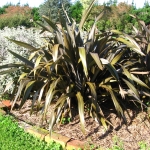
Phormium cookianum Purpurea is a red foliaged variety of the Mountain Flax. Flower spikes rise above the plant and bear twisted looking flowers, to which birds are attracted for the nectar. Curiously, many of the red varieties don't flower, however the purples, greens and yellows do.
Flowering: Spring [October - December]
Fruiting: Summer [January - March]
Phormium Emerald Gem (Dwarf Green Flax)
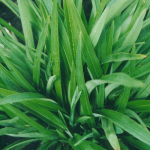
Phormium cookianum Emerald Gem is very popular for amenity planting, as it is smaller growing than Phormium cookianum. This dwarf variety of Flax produces narrow, sword like leaves that are a striking emerald green colour. Through summer it produces yellow flowers on tall stems that attract all manner of birds. This variety typically grows to 60 cm tall and 70 cm wide with a tidy and compact habit. Emerald Gem is a versatile plant that makes a fantastic addition to mixed plantings and borders, using in coastal gardens, planting to accentuate water features such as ponds and streams, or growing around pool and barbecue areas. It is also well suited for mass planting on a bank and in these situations provides an impressive display.
It performs best when planted in full sun on a well-drained site though it will tolerate frost, coastal conditions, wind, poor soils, moderate shade, and cool climates.
Flowering: Spring [October - December]
Fruiting: Summer [January - March]
Phormium tenax (Harakeke, Swamp Flax)
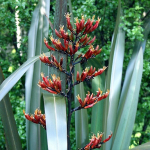
Phormium tenax, Harakeke, commonly called Swamp Flax, is one of the oldest plant species in New Zealand and it is unique to New Zealand. With its sword-shaped leaves it is a common feature of the New Zealand landscape. It grows up to 2 -3 metres high and its flower stalks can reach up to 4 metres. The flowers are brownish red in Summer, followed by black seed pods that stand upright from the stems. It is very hardy and fast growing with wide environmental tolerances. It will grow in dry and wet conditions, withstand strong and coastal winds and are frost hardy. It is used for hedging or shelter and in mixed native planting. It is also a pioneer plant meaning it should be one of the species planted first in a restoration planting plan as it establishes quickly when planted and shelters other plants.
Plant communities that include Apodasmia similis, Carex maorica, Carex secta, Carex virgata, and Eleocharis acuta often contain Phormium tenax.
History of use: Traditional uses of flax No fibre plant was more important to Maori than flax. Each pa or marae typically had a pa harakeke or flax plantation. Different varieties were specially grown for their strength, softness, colour and fibre content. Traditionally when harakeke leaves were removed from the plant, only the older leaves on the outside were taken. It is believed the three inner layers of the plant represented a family. This outer layer represented the grandparents, whereas the inner layer of new shoots or the child remained to be protected by the next inner layer of leaves, the parents. The uses of the flax fibre were numerous and varied. Clothing, mats, plates to eat off, baskets, ropes, bird snares, lashings, fishing lines and nets were all made from flax. Babies were even given rattles made from flax. Other parts of the plant were also used. Floats or rafts were made out of bundles of dried flower stalks (kokari). The abundant nectar from flax flowers was used to sweeten food and beverages. Flax also had many medicinal uses. The sticky sap or gum that flax produces was applied to boils and wounds and used for toothache. Flax leaves were used in binding broken bones and matted leaves were used as dressings. Flax root juice was routinely applied to wounds as a disinfectant. Today, flax is used in soaps, hand crèmes, shampoos and a range of other cosmetics. Flax seed oil can also be found for sale.
Habitat: Common from lowland and coastal areas to montane forest, usually but not exclusively, in wetlands and in open ground along riversides.
Flowering: Summer [November - December]
Fruiting: Summer [January - April]
My Lists: Erosion Control, Wetland, Pioneer Species
Phormium tenax Purpurea (Purple Swamp Flax)
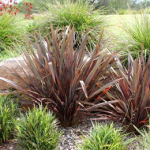
Phormium tenax Purpurea is a red/purple foliaged seedling form of P. tenax, so there is some attractive variation between plants. Generally smaller in stature than the green form. A strong-growing flax forming a red/purple clump. Plant next to shrubs with lighter colouring for best effect.
Flowering: Spring [October - December]
Fruiting: Summer [January - March]
Pimelea declivis
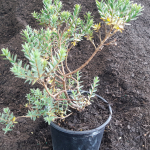
Pimelea declivis is a small blue-green erect shrub native to Canterbury. Inhabiting limestone outcrops from south Marlborough to south Canterbury.
Habitat: Lowland to lower montane, Mostly found in sparse grassland and grey scrub associated with limestone ridges, scarps, cliffs, outcrops, screes and boulder heaps.
Flowering: Spring - Summer [October - May]
Fruiting: Summer - Autumn [November - May]
My Lists: Rare Plants
Pimelea prostrata (Pinatoro, NZ Daphne)
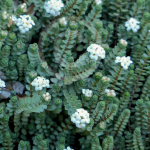
Pimelea prostrata, Pinatoro, or NZ Daphne, is a native groundcover with an attractive low growing plant with white flowers. It flowers prolifically over the summer months and is followed by small clear, white berries. The outstanding blue green foliage is a stand out with this groundcover. Is best grown in a free-draining soil in a full sun position. Excellent for sunny banks or rockeries.
Habitat: Coastal to montane. In open sites, such as coastal gravel, sand dunes, grasslands and mudstone cliffs.
Flowering: Spring - Autumn [September - May]
Fruiting: Winter [October - July]
Plagianthus divaricatus (Makaka, Salt Marsh Ribbonwood)
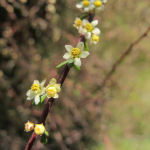
Plagianthus divaricatus, commonly called Salt Marsh Ribbonwood, is a dense twiggy shrub with small narrow leaves. Small sweetly scented flowers. Good hedging, deciduous, cold hardy. Will tolerate salt winds and wet soils. It can be found in association with (but not limited to) Coprosma propinqua, Muehlenbeckia complexa, Cyperus ustulatus, and Phormium tenax.
Found in sheltered coastal shorelines throughout New Zealand, in areas with salt swamp, sandy banks and throughout estuaries. As its common name suggests, it is salt and wet tolerant. As with P. regius, it has a juvenile and adult form where the leaves become larger as it grows. Used as a coastal wetland and restoration plant.
Habitat: Found alongside salty swamps or damp gravelly places in coastal regions.
Flowering: Spring [September - November]
Fruiting: Summer [December - March]
My Lists: Erosion Control, Wetland
Podocarpus nivalis (Snow Totara)
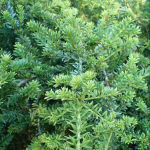
Podocarpus nivalis, commonly called Snow Totara, is a low growing, almost prostrate shrub found in sub alpine parts of New Zealand, although can grow at low altitude as well. It has small leathery olive-green leaves and edible red berries in the autumn. Fantastic option for a trimmed low hedge.
Habitat: Montane to alpine. Common in open tussock grassland and subalpine scrub.
Flowering: Spring [September - November]
Fruiting: Autumn [December - June]
Podocarpus totara (Totara)
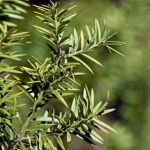
Podocarpus totara, is a classic NZ Native with needle like leaves, olive green, orange-red fruit. Bark red / brown, good shaped tree with durable timber. Tolerates wide range of sites. Evergreen. Frost tender when young.
Commonly known as Totara, trees are either male or female with the female trees having bright red, berry-like fruit in autumn. Male trees do not bear fruit. It grows with a broad and spreading habit to eventually reach 20 m tall and 10 m wide, and can be included in a medium sized garden due to its slow growth rate. Best results with this tree are achieved when it is grown in full sun on a well-drained site. It is tolerant of mild drought, frost, cool climates, some wind, and coastal environments. Totara is commonly included in a mixed planting in a large garden, used in native plantings, or grown as a specimen.
Habitat: Widespread and at times abundant tree of lowland, montane and lower subalpine forest. May also form a vegetation type in which it is the dominant species.
Flowering: Spring [October]
Fruiting: Autumn [March - May]
Pseudopanax arboreus (Whauwhaupaku, Fivefinger)
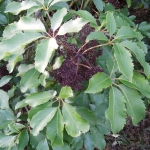
Pseudopanax arboreus, commonly called Fivefinger, is one of New Zealand's most common native trees found from Cape Reinga to Bluff in lowland forests. Its particular form of a glossy, five to seven fingered leaf along with quick and luxuriant growth. It grows into a small stout tree up to 5 metres high and grows well in most soils and situations. Fast growing with small purplish black berries in autumn.
History of use: New Zealand Beekeepers Magazine rates Pseudopanax arboreus as a star performer for food for bees. The trees provide abundant pollen and copious, rich nectar very early in the season when few other species are in flower (from June to August). Plant in good numbers clustered together to amplify the availability of flowers for bee feed. Bees love the small scented green flowers that are followed by bunches of dark purple fruits enjoyed by birds from August to February. Flower buds can be easily mistaken for ripe fruit whereas clusters of fruit are actually ripe one year after flowering.
Habitat: Coastal to montane. Moist broadleaf forest. Frequently epiphytic. A frequent component of secondary forest and forest margins. Tolerant of moderate frosts and coastal conditions but should be sheltered from strong winds.
Flowering: Winter [June - August]
Fruiting: Spring - Summer [August - February]
My Lists: Winter Pollen
Sophora microphylla (South Island Kowhai)
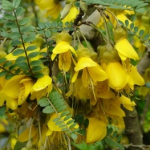
Sophora microphylla is also known as South Island Kōwhai, having showy yellow flowers in early spring. This particular Kōwhai has very small leaves (microphylla) and a tangled juvenile form, tending to straighten up and grow from an upright trunk at about four years. Kōwhai makes a good garden tree and is necessary for revegetation projects as a bird attractor. Kōwhai are suited to upper bank plantings of riparian areas. They also make beautiful shade or specimen trees. Semi-deciduous. Hardy.
Sophora microphylla have horn-shaped yellow flowers. The nectar is a favourite food for Tui, Bellbird and Kererū which also eat the leaves. The seed pods which appear after flowering stay hanging on the tree through winter.
Kōwhai is the national flower of New Zealand.
Habitat: In the North Island, especially the northern half this is a species of mainly riparian forest. South of Hamilton it can be found in a diverse range of habitats from coastal cliff faces and associated wetlands to inland grey scrub communities. Sophora microphylla and Sophora prostrata are the only forms naturally existing in Canterbury.
Flowering: Winter [August - October]
Fruiting: Spring - Summer [October - May]
My Lists: Winter Pollen
Sophora prostrata (Dwarf Kowhai)
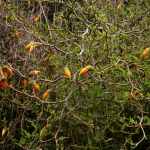 Sold Out
Sold Out
Sophora prostrata, commonly known as Dwarf Kowhai, is a low-growing shrub or small tree species that belongs to the family Fabaceae. It is native to New Zealand and is known for its vibrant yellow flowers and unique, prostrate growth habit.
One of the most distinctive features of Sophora prostrata is its striking yellow flowers, which are pea-like in shape and arranged in clusters at the ends of the branches. The flowers usually appear in late winter or early spring, and their bright yellow color is a standout feature against the dark green foliage. The flowers are attractive to bees and other pollinators.
Sophora prostrata is endemic to New Zealand, where it is found in a variety of habitats including coastal cliffs, sand dunes, shrublands, and forests. It is particularly well-adapted to tolerate salt spray and harsh coastal conditions, which makes it suitable for coastal gardens and landscaping.
Sophora prostrata serves as an important host plant for the caterpillars of several native butterfly species. Additionally, Sophora prostrata is a popular ornamental plant in gardens and landscapes due to its attractive flowers and unique growth habit. Semi-deciduous. Very tough on exposed, cold, dry sites.
Habitat: Found from the coast to subalpine in open rocky planes. Confined to the eastern South Island from Marlborough to the Waitaki Valley.
Flowering: Spring [September - October]
Fruiting: Summer [January - February]
Sophora tetraptera (North Island Kowhai)
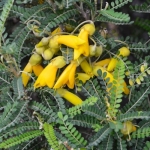
Sophora tetraptera is commonly known as the North Island Kowhai or large-leaved Kowhai that grows naturally only in the central east of the North Island. It has larger, more widely spaced leaves than other species. It is a great specimen to provide some contrast in a strictly native garden with its early abundance of yellow flowers in early spring which are a favourite food of the Tui and other bird life. Frost tender when young,
Habitat: Widespread and common from coastal forested habitats inland along rivers and within associated low scrub and forest. Common around lake margins (especially Lake Taupo) and on ignimbrite cliffs bordering the upper Waikato River. Although a primarily lowland species it can occur in montane riparian forests.
Flowering: Winter - Spring [July - October]
Fruiting: Spring - Summer [October - May]
Veronica salicifolia (Koromiko, Hebe salicifolia)
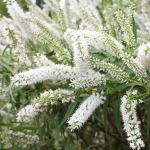
Veronica salicifolia, Koromiko, formerly called Hebe salicifolia, is a fast-growing large, spreading shrub. Provides good low shelter and is an excellent revegetation plant. It has showy white to pale lilac drooping flowers and willow-like foliage. Prefers a moist soil. Trim after flowering in a garden setting.
Veronica salicifolia is a hardy plant but isn’t tolerant of shade and needs to be grown in full sun and in a sheltered area with well-drained soil. It can, however, tolerate wet areas and can often be found on the edge of bush and wetlands. Once established they have considerable drought and frost tolerance.
History of use: The Māori utilized the plant’s medicinal properties for centuries. The leaves were chewed to help cure diarrhoea and applied to the skin to aid ulcers and wounds. Koromiko is the general name for the Hebes in Te Reo and is shared over a range of New Zealand Veronica species.
Habitat: Occurs from sea-level to close to the treeline, mostly in open sites, and forest margins. Is used in lower bank riparian edges where their roots can dry between rain events, but the soil stays damp.
Flowering: Summer [December - May]
Fruiting: Autumn [January - June]
My Lists: Pioneer Species
